#Philippine native trees
Text
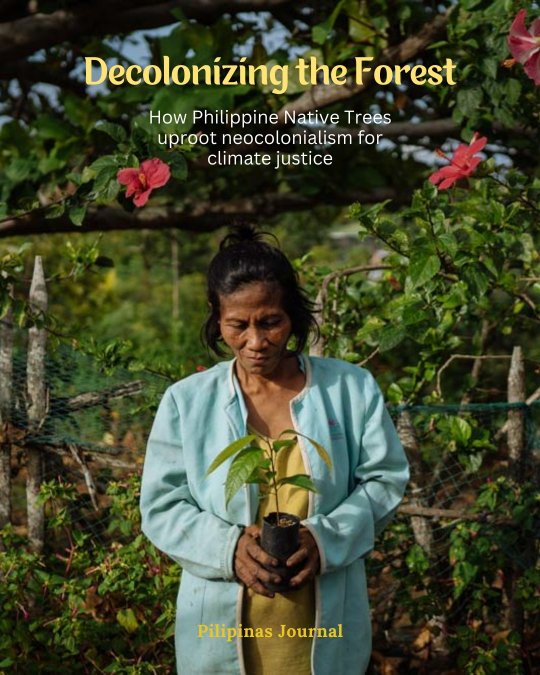

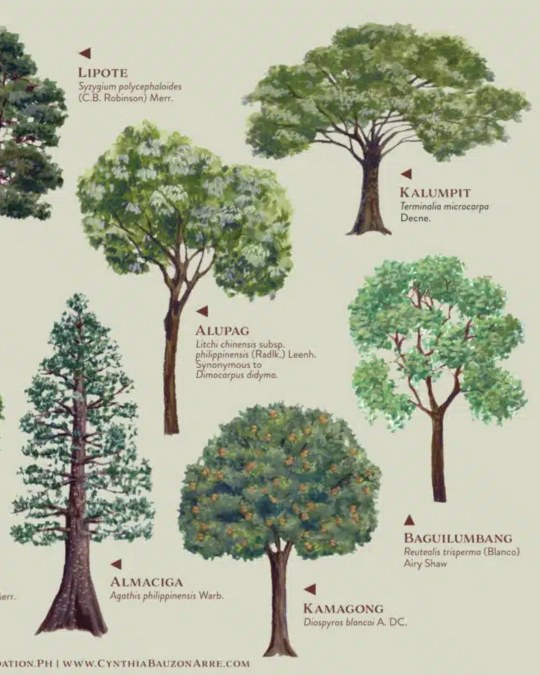

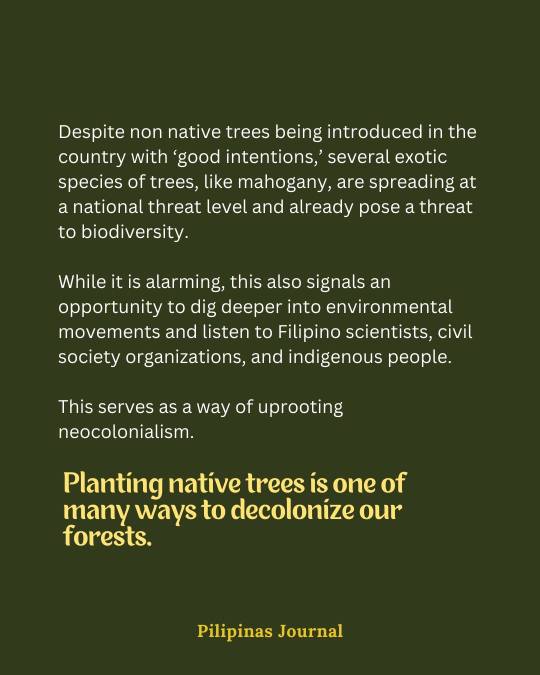
From Pilipinas Journal Instagram Page: Planting native trees is part and parcel of a broad process of uprooting neocolonialism and building climate resilience. Given that they are tied to their relationship with the rich Philippine soil, planting native trees in the country is one of many ways to decolonize our forests. Other than that, planting native trees may not be the sole answer or cure-all to systemic climate injustice, but doing this will manifest our respect for our indigenous roots and honor Mother Earth.
Discover the profound connection between our forest ecosystem, neocolonialism, and climate resilience in their latest article.
#philippines#not a lit post#decolonizing the philippine forest#essay#philippine native trees#philippine wild life
90 notes
·
View notes
Text

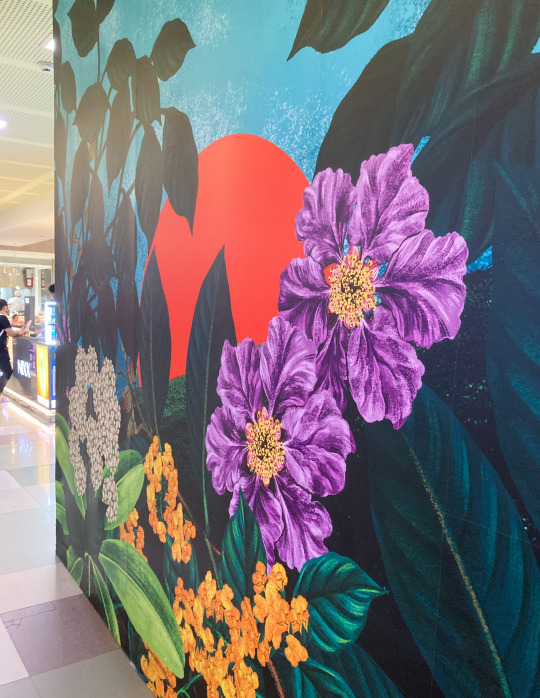


Banaba flowers, and even products & artwork in and around my biking grounds in Manila.
I’m beginning to see more and more local products using Banaba (𝘓𝘢𝘨𝘦𝘳𝘴𝘵𝘳𝘰𝘦𝘮𝘪𝘢 𝘴𝘱𝘦𝘤𝘪𝘰𝘴𝘢). It has long been a traditional medicinal source for various communities in the country. Banaba is native to Southeast Asia, and has been long known for its antidiabetic, anti-inflammatory, and antioxidant properties (DOST PCHRD*).
Maybe one day every home will have a Banaba tree, helping urban ecosystems thrive with life and biodiversity. What local and native trees grow in your neighborhood? How have some of them been utilized by your neighbors and Indigenous communities? These are our health heirlooms, passed down by generation, and germination.
Learn more about Banaba and more of our "forest friends" at the Haribon Foundation:
https://haribon.org.ph/support-our-work/rainforestation/forest-friends-of-the-philippines/meet-banaba/
*Department of Science and Technology, Philippine Council for Health Research and Development
19 notes
·
View notes
Photo
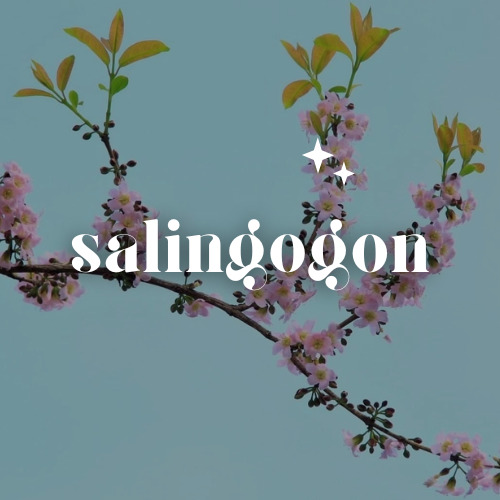

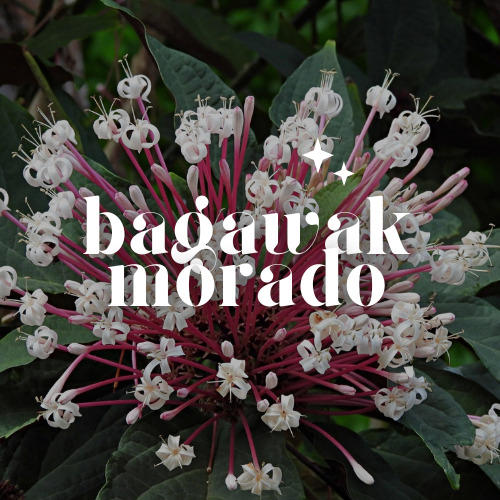

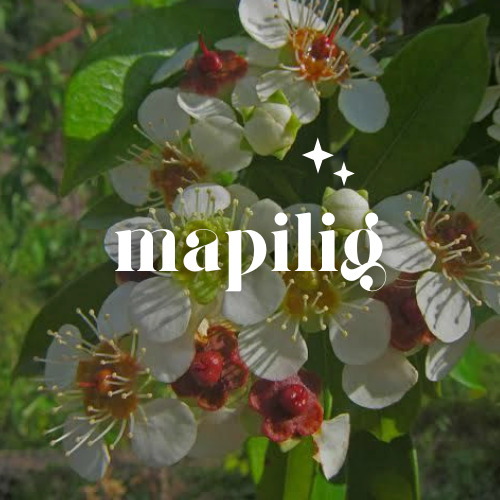
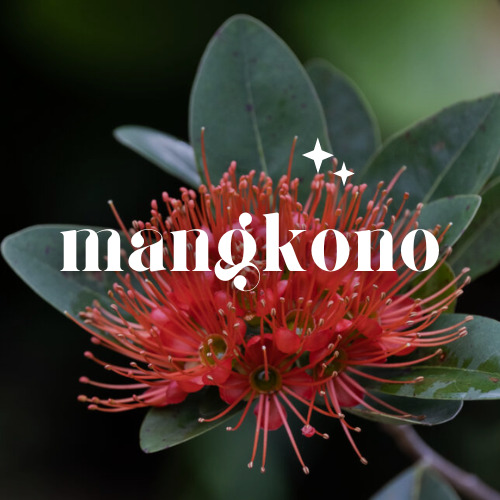

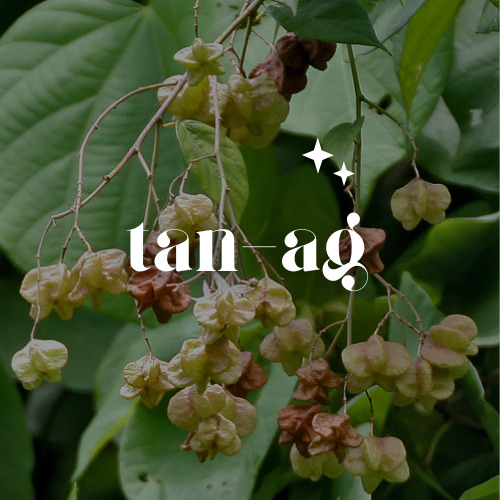
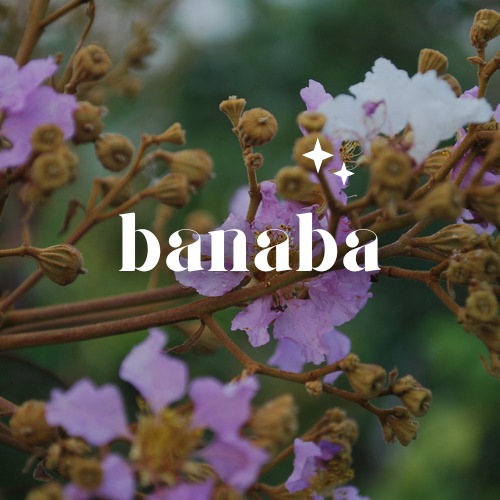
Ilan lamang ang mga ito sa magagandang puno sa Pilipinas. Paborito ko siguro rito ang Salingogon at Banaba. Mukha silang Cherry Blossoms at Wisteria.
101 notes
·
View notes
Text
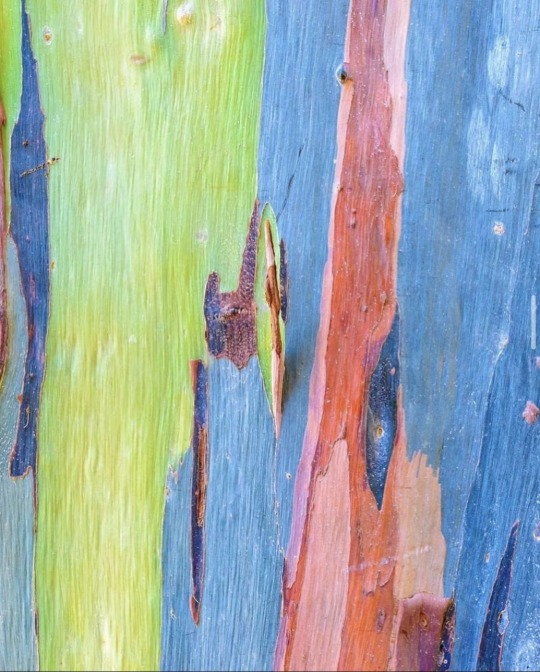


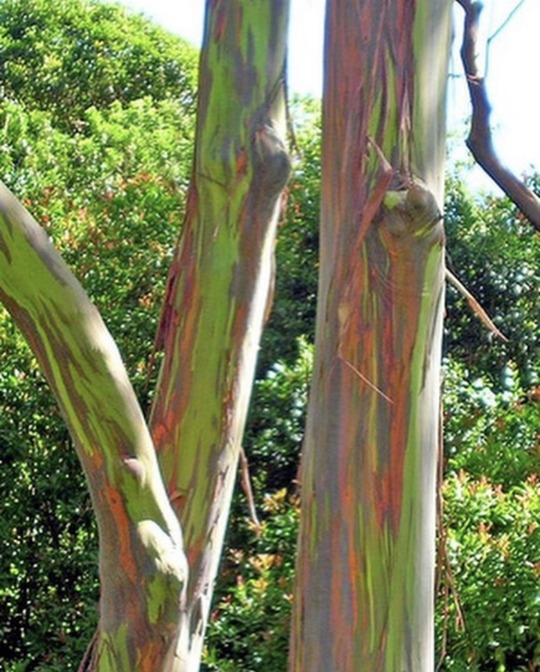
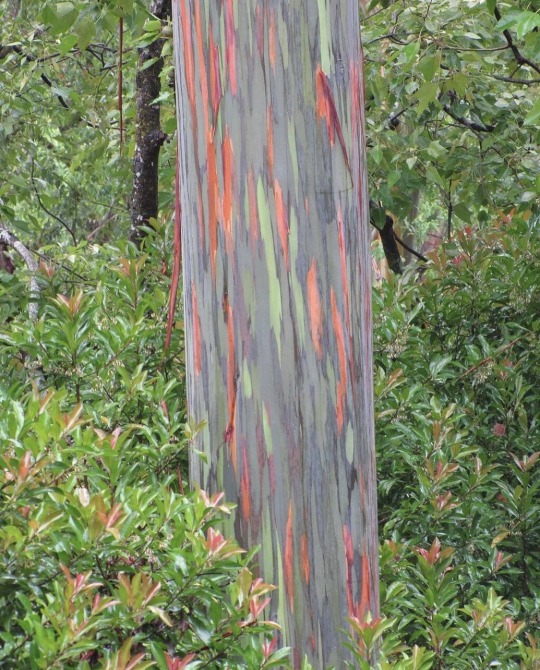

Rainbow Eucalyptus Trees
Eucalyptus deglupta is a species of tall tree, commonly known as the rainbow eucalyptus, Mindanao gum, or rainbow gum that is native to the Philippines, Indonesia, and Papua New Guinea. It is the only Eucalyptus species that usually lives in rainforest, with a natural range that extends into the Northern Hemisphere. It is characterized by multi-colored bark which starts with bright green patches that will gradually transform into orange, maroon, and blue hues.
#forestcore#fairycore#rainbowcore#naturecore#sciencecore#rainbow#science#eucalyptus#trees#nature#aesthetic#cool#cool science#nature facts#photography#forest#woods#rainforest
491 notes
·
View notes
Text
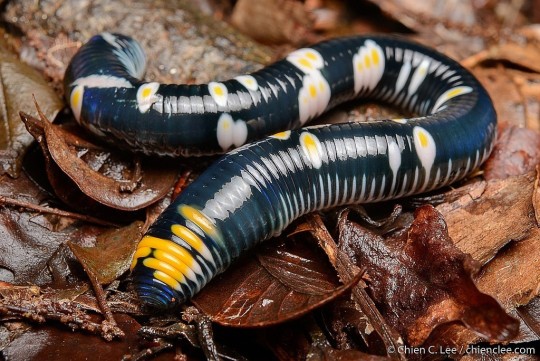
Name: Fried Eggs Worm (Archipheretima middletoni)
Debut: Real Life
What the! Whuzzah! That's a! WOW! This is how I felt upon learning about Fried Eggs Worm for the first time, and I hope you feel the same way, because MY GOODNESS! In this world, there exists an earthworm, which is a deep blue, and has spots that look just like sunny-side-up eggs. Sometimes it looks like the yolk was punctured and spilled out! Better hope a Toast Worm is nearby to sop that up!
I could not BELIEVE I had not learned about this creature until just a few months ago, and I could not let it be obscure any longer. This is one of the most incredible creatures, and now you know about it, too!
Perhaps the reason for its obscurity is that it was only "formally" discovered and named rather recently, in 2009. Of course, the people who had been living in its native range in the Philippines had known about it long before that! How could they miss it, really? I will remind you: this worm has Egg Imagery all over its body.

Some local folklore suggested that these silly little wigglies might be the juvenile form of an eel species from a nearby river, and if you're familiar with eel development, something that strange doesn't seem all that out of character for an eel. The truth is, the Fried Eggs Worm is quite out of character for an earthworm! It is more of a leaflitterworm, because instead of burrowing in the soil, it burrows in the leaf litter. It is thought that the funny spots might help it camouflage in there by resembling light pouring through the leaves, kind of like a baby deer's or tapir's spots!
The Fried Eggs Worm does not spend ALL of its time in the leaf litter. Oh, no. It isn't even born in there. It's born in a doggone TREE. Their babies have been found in the leaf axils of the pandanus tree, meaning their parents CLIMB TREES in order to reproduce. Arboreal annelids! These limbless tubes are better at climbing trees than we are, and we're apes! And more ridiculous still, so far only one baby worm has been found per tree. These babies might each get an entire tree all to themselves with no competition. Is that really necessary? I think Fried Eggs Worm may be showing off, but it has every right to do that. I hope it continues!
Fried Eggs Worm should be the new Easter mascot. Nothing against rabbits, but they're one of the most popular animals. They have enough, I think. And they're not Egg at all! They don't lay eggs, and they don't have any visual egg motif. Fried Eggs Worm, however, lays eggs, and is covered in egg iconography! Second only to Fried Egg Jellyfish.
In conclusion, this eggcellent creature worms my heart, and I hope you feel the same way, especially if you did not know of them before! It feels representative of the fact that we will never know every creature of this world, and there will always be more to learn!
If you're a REALLY devoted Fried Eggs Worm Superfan and want to show it to the world, use this simple guide to steal their look!

-blue
-egg
286 notes
·
View notes
Text
Animal of the Day!
Mindoro Bleeding-heart (Gallicolumba platenae)

(Photo from Animalia Bio)
Conservation Status- Critically Endangered
Habitat- Philippines
Size (Weight/Length)- 200 g; 30 cm
Diet- Fruits; Seeds; Insects
Cool Facts- This bird is completely fine, that’s just their measure of horniness. I’m not joking. During the breeding season, males puff out their chest and strut their stuff for females. The brighter the red, the more fit the male. Mindoro bleeding-hearts live in small flocks alongside green pigeons as they forage for fruit. Unfortunately, these doves are under extreme threat from illegal logging and dynamite-blasting for marble. An estimated 50-250 adults survive. Conservation groups are working to map the forests of Mindoro and do an in depth population survey. There are future hopes for a captive breeding program to bring these birds back from the brink. In addition, they are working with local people to plant native trees to replace areas that were previously logged.
Rating- 13/10 (As a wise man once said “Shot through the heart and you’re to blame…”)
#animal of the day#animals#birds#doves#monday#september 11#mindoro bleeding-heart#biology#science#conservation#the more you know
744 notes
·
View notes
Text
The Colugo: these mammals are able to glide through the air using a fur-covered membrane that stretches across their bodies; as a baby, a colugo that has not yet learned how to glide on its own must cling to its mother's belly instead
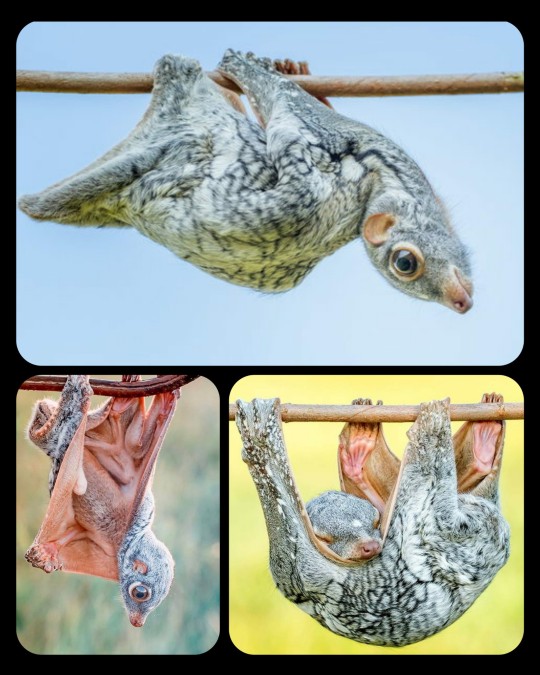
These critters are often referred to as "flying lemurs," though they aren't actual lemurs. Genetic studies have indicated that they are among the closest living relatives of primates, occupying a sister group.

Colugos are native to the tropical rainforests of Southeast Asia, where they are traditionally divided into two extant species: the Philippine flying lemur (Cynocephalus volans), which resides in the Southern Philippines, and the Sunda flying lemur (Galeopterus variegatus), which can be found in parts of Vietnam, Laos, Cambodia, Thailand, Myanmar, Malaysia, and Indonesia.
The fur-covered membrane that stretches across the colugo's body is known as a patagium; a similar membrane can be found in other gliding mammals (e.g. flying squirrels, sugar gliders, mahogany gliders, etc.) but the patagium of the colugo is uniquely extensive, surrounding almost all of the animal's body margin and stretching even between the tail and hind legs.
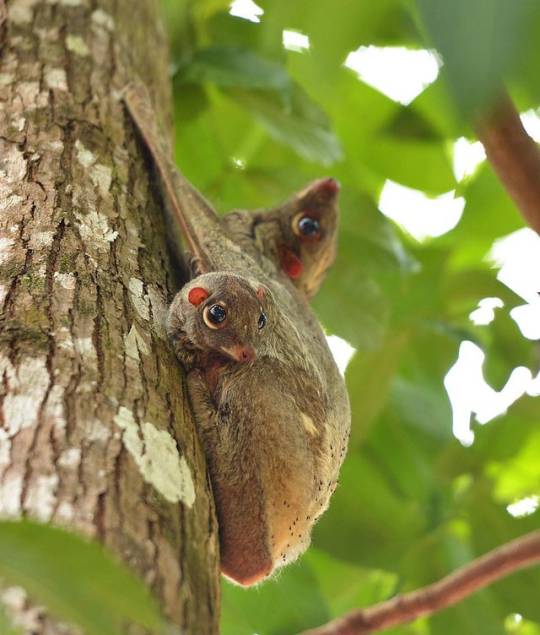
When they are not actively gliding, female colugos often pull their tails up against their bellies, effectively curling the patagium into a pouch in which they can carry/protect their young. When gliding, however, the mother must fully extend her patagium, meaning that she has to unfold the pouch and allow the baby to curl itself around her torso (and hold on tight) befor she can begin gliding.
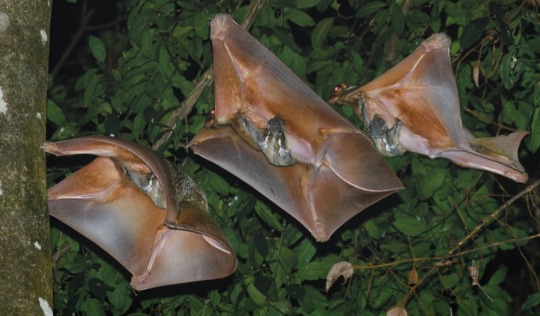
Colugos have a more extensive patagium (and therefore possess more "wing space") compared to other gliding mammals, which enables them to glide much further. There is at least one documented case in which a Sunda colugo was observed gliding across a distance of 145 meters -- nearly the length of three Olympic-sized swimming pools. Another study also indicates that this species is able to glide a total distance of 1,342 meters per night (and can climb a total of 320 meters up into the trees in order to do this).
These critters also have extremely strong claws, and the soles of their feet are able to mimic suction-cups to help them maintain a tight grip on tree trunks and branches. Colugos are most active at night, and they are strictly herbivorous, feeding only on young tree leaves.
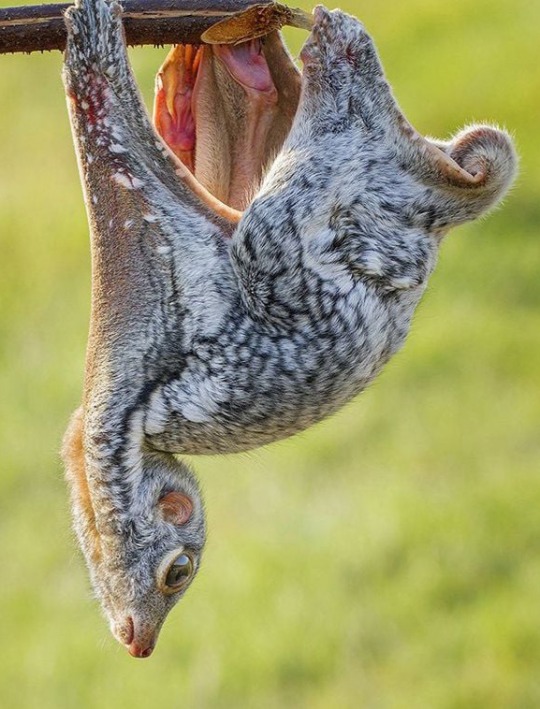
I don't normally feature mammals on my blog, but this one in particular seemed too heartbreakingly adorable and too weird for me to ignore. I mean, look -- it's like a tiny dinosaur wrapped in a Snuggie!
Sources & More Info:
Science News: On a cool night in Malaysia, scientists track mysterious colugos across the treetops
Animal Diversity Web: Galeopterus variegates (the Sunda flying lemur)
BioMed Central Journal of Biology: Colugos -- obscure mammals glide into the evolutionary limelight
World Wildlife Fund: Flying Lemurs
National Geographic: Why do flying lemurs glide?
Encyclopedia Britannica: Flying Lemur
Animal Diversity Web: Cynocephalus volans (the Philippine flying lemur)
#animals#nature is weird#science#biology#zoology#flying lemurs#gliding mammals#cute#weird animals#sunda#nature#colugo#these#guys#probably#give#the#very#best#hugs
613 notes
·
View notes
Text
So I'd like to talk a bit about the Filipino funeral gold scandal and how as someone writing an anti-colonial Filipino epic fantasy based heavily on early shaman lead rebellions against Spanish colonial rule I have some intense feelings about Filipino actress Beauty Gonzales flaunting wearing funerary death masks taken from a Large number of graves in surigao, butuan and mindinao and rather then treating them with appropriate respect or any kind of cultural ethics and instead turning them into fashion jewelry.

Aside from the damage to important archeological artifacts the utter disrespect shown to the dead who were interred in this way to ensure thier successful passage into the afterlife and to protect their bodies from the entry of evil spirits
For me it calls to mind when I was doing my primary sources research for Saints of Storm and Sorrow into the tree and boat burials of Luzon and reading the accounts of precolonial funerary practices by early Spanish friars and "naturalists" one of these documents was the memoir of Domingo Sanches who in a particularly horrifying account, noted how in the village he was staying in a young girl had died and he recorded how she was mourned and the great love and ceremony with which she was buried and how later that night he snuck back, dug up her grave and stole her body for research purposes. I remember he noted the great hostility of the natives when they discovered his theft and how he'd be unlikely able to return. I can't help being horrified at the thought of a Filipino actress adding to this horrible history of grave robbing and disrespecting the dead. To the colonialist mentality of taking spiritually important items and turning them into decorations. The level of disrespect is staggering. This is not the way to reconnect with our precolonial culture. I'm utterly horrified the more I look at this image and think about all the people who thought this was acceptable

For anyone interested in further reading
News articles citing art and museum critics disapproval
The screenshotted article with snippets from the Spanish naturalists memoir
History of funerary death masks and thier significance
#saints of storm and sorrow#Philippines#filipino#filipino culture#history#fashion#scandal#cultural artefacts#writing research#archaeology#colonialism#filipino history#filipino fashion#filipino author#grave robbery
158 notes
·
View notes
Text
Hey. It's @reaux07. If you remember my last angry history rant on Paul Robeson, I'm back for Part 2. This time? King Leopold II and his relationship to the Congo. I just finished writing a 5-page, single-spaced essay on this for class, so I'll do my best to summarize in bullet points this time rather than chunky paragraphs. This will still be long though, as a warning, but it's a necessary read. Please let me get through this, because y'all know this hurts to write.
Trigger warnings for... just about everything typically associated with mass colonization (e.g. rape, murder, torture, etc.). Tiktok below as a brief introduction first:
King Leopold II of Belgium, due to his personal unpopularity and lack of love from his parents, had low self-esteem. As his father had already made 50 attempts to colonize foreign lands to no avail, Leopold felt the only way to uplift both himself and his country was to take take control of his own colony.
He checked Sarawak, the New Hebrides, the Fiji Islands, and the Philippines. Nothing. But what was left? The Congo.
How did he learn of the Congo? Leopold hired Henry Morton Stanley, a famous Welsh explorer of the time, to cross Africa from east to west, walking and canoeing 7,000 miles.
Upon the Congo's discovery, Leopold turned his palace into a luxury hotel for the delegates of a new conference to discuss Africa's colonization, supervising every detail. He successfully lied to the major powers of Europe, making claims of charitable and philanthropic aims, and that there would be free trade amongst the African colonies. (And yes, he did give every single attendee a painting of his face... Because he could.)
Meanwhile, back in the Congo, Stanley (the explorer I just mentioned) used bribes and trickery to provide official treaties with the various chiefs of the land in case Leopold ever needed legal proof of land ownership. (Ex of said trickery: One report noted that a village assumed "the white man controlled the sun.")
In 1891 and 1892, Leopold released decrees stating that both vacant land and produce of the forests exclusively belonged to Belgium and that natives could only harvest for the state.
Enforcing Leopold’s rule were 16,000 Africans equipped with modern Belgian-made automatic rifles.
Outing Attempt #1: One African American man, George Washington Williams, during his trip compiled a report to be sent to the American secretary of state. In this letter, Williams remembers bets being taken on who could shoot the native people in the head first, among other instances of vile treatment. While the document never made it back to Williams’ home country, it was eventually found in Europe where he later died.
By this point, the Congo was actually ruining Leopold’s finances and he was growing desperate. But to his surprise, he happened to pick the one spot where rubber grew in abundance, just as the demand for cars and bicycles rose internationally, John Dunlop, a Scottish veteran, having just invented the first pneumatic tire.
Because of this, rubber-prominent areas were the targets of mass exploitation and punishment if daily and weekly rubber quotas were not met.
Missionaries began to write not just to one another, but back home in disgust of these aforementioned “punishments,” one man’s writings put in missionary magazines and national newspapers in Europe. These punishments included rape, tying people up to trees, cutting off men's heads and genitals to be displayed along the fences of Congolese villages, cutting women’s breasts off, and most notably...
Attempt #2: The world, if only momentarily, saw BASKETS after BASKETS of right hands that had been cut off as proof that each of the cartridges given to the Africans had been fired and killed one of their own people. These hands were then smoked for preservation and brought back to their officers.
What did Leopold do once this information came out alongside photos of child mutilation? Acknowledge the abuses and moved on almost immediately.
In Europe, the rubber was processed in a city called Antwerp, ironically named after a mythological giant who also cut off hands. To this day, the connection between such a name and Belgian history has not been made by the general public as countless documents by the Belgian Ministry of Foreign Affairs are kept secret to maintain an image of untouched royalty.
One commissioner in charge of a district in Congo, Leon Fievez, produced one ton of rubber a day, boasting of 1,000 people killed, 162 villages destroyed, burning gardens and plantations so people would starve, and having “only” used 3,000 cartridges. He was nicknamed the “Devil of the Equator” and rightly so.
Attempt #3: One day, a man named Charles Stokes, a British trader working for the Germans, entered the picture. Stokes was arrested for trading in state territory, despite those former claims of free trade, and sentenced to death. Leopold was forced to pay compensation to both Britain and Germany for his death, both countries now increasingly aware of the Congo’s dark reality.
To cover it up, Leopold made claims of the Congo opening up to new companies. Let's be real: His men were on the boards of all these new companies and he took 50% of the profits.
In particular were these "concession companies" where the "hostage system" was set up. Agencies, with official hostage licenses authorizing such, would take the wives of rubber collectors for up to 15 days until the quota was met.
On the 15th day, the men of the Congo either got their wives back or faced further punishment, often death. For the agents, the 15th day meant it was time to calculate commissions, and for the king? It was proof that this new hostage system worked.
These abusive concession companies lasted over 10 years until formal competition arose in South America and Asia.
Attempt #4: Then came Edmund Dene Morel, a half-French, self-taught shipping clerk turned investigative journalist who wrote in The Speaker of the abuses faced by the Congolese, backed up by evidence, not just speculations.
Due to Morel’s growing specialization in West African affairs, he was able to not only send out 15,000 brochures and 3,700 letters in six months after his move to Wales, but start his own newspaper, West African Mail.
By 1903, Roger Casement, an ally to Morel’s cause, spent two months traveling the upper Congo, recording African testimonies. He, too, realized that missionaries were key witnesses and went to visit Joseph Clark (a missionary of 20 years) for 17 days.
Through these reports, which grew to 50 pages in length, Casement and Morel were able to solidify Belgium as perpetuating the worst colonial system Africa had ever known. Punishments included Africans performing public incest for the colonists' entertainment, decapitation, women being stabbed with wooden spikes up their vaginas, and one woman tied up to a tree and slashed straight in half from her left shoulder through her abdomen and out the other side.
The West African Mail even reported on a part of Congo no one knew existed, private property within private property called the “Crown Domain” on the other side of Lake Tumba, which gained 231 million euros alone, all sent directly to King Leopold II. Crown Domain was 10x 5)3 size of Belgium.
Founded by Morel, Liverpool became the headquarters of a coalition called the Congo Reform Association. He also published a book called Red Rubber (1906). I think you’ll find the cover particularly striking! Check out the hand in the bottom right corner being weighed against King Leopold II on the left.

Leopold obviously not having this, commissioned a number of books and monthly magazines to clear up the mess. This didn't work. Obviously.
He even tried to send his own international commission to control what the Congolese said in 1904, to no avail. This was due to a missionary named John Harris who had taken the accounts of various people in the area and sent them back to Morel.
In one particularly heartbreaking moment, a chief brought to Leopold’s judges 110 twigs for each of the entire villages, not just people, killed by the Belgian state, naming every last one.
By the time they returned to Europe, the governor-general committed suicide and, upon being asked, Harris suggested Leopold should be sent to the gallows by the relatively new International Court of Justice.
The commission's report vindicated Casement and Morel. Leopold had tricked no one. EVERYONE in Belgium was calling him out.
Leopold ordered all of the Congo State Records to be burned.
In 1908, the Congo became a Belgian colony, not longer Leopold’s personal property. The state still made claims of "civilizing" the Africans after Leopold's death though, utilizing the leftover mineral exploitation industry with no guilt.
At least during his funeral, which he was denied of having privately, the entire city booed his body <3 well deserved. By this point, he had become Europe’s most hated man of the time.
And in case you were wondering, Casement and Morel were both accused to pro-German sympathies during WWI and executed.
I would like to add more detail but I think I’ve hit a character limit. Just know that Congo’s population was cut in HALF, in some places as much as 60-90%. Villages after villages were burned, as shown through so many soldiers’ and missionaries’ journals. This was a genocide of over 10 MILLION PEOPLE y’all. Hearing this story was truly SICKENING, but here’s the BBC 4 documentary we watched for class for more: Congo: White King, Red Rubber, and Black Death.
What truly gets me is just how OTHER colonizers were calling this man out after finding out the full truth… For me, that feels like extra proof of how truly messed up this was if THEY were disturbed too.
And what feels truly insidious was how Leopold made sure to institutionalize all of his wrongdoings and was so… obviously knowing about every wrongdoing, I mean writing in letters to make sure no one else found out. Please…
Linking my angry history rant on Paul Robeson from last semester here.
Happy Black History Month.
#belgium#king leopold ii#democratic republic of congo#history#black history month#colonialism#tw genocide#tw rape#tw torture#tw massacre#the congo#tw incest#resources#bipoc#undescribed#reaux speaks#black lives matter
196 notes
·
View notes
Text
flower/plant in dramas
Prompted by the conversation I had with @colourme-feral about plumeria and jasmine being featured in the first episode of I Feel You Linger in the Air (and also, plumeria was featured in KinnPorsche during the scene with Khun Spikes our beloved), I was tempted to write this post. Honestly, I always love to see how flowers or plants or even parks (not theme-parks) are used in dramas. Flowers and plants give visual localities and in many cases it's a part of natural and cultural elements of a place where the drama is set. And for me, it is always interesting to see how people 'place' their priority on parks, or to some extent, forests, through a piece of media; are they treated just as a side / decorative elements (as an escapade, or simply a break, destination, maybe), or as center stages? (Sorry, I was once an architecture/landscape architecture graduate and still, until today, have this default interest towards these living elements -- tropical flowers and forests my beloved! --, and since I LOVE watching my Asian shows, how they were presented there - will I always write about them, though, that's another case.) So, I am thinking of making some posts about flowers in dramas (specifically in Thai dramas). As I focused more on the Southeast Asian context, I might miss some facts about of the flower(s) from the perspective of other regions, but hopefully I didn't leave out anything significant.
part 1 - plumeria/frangipani
Plumeria (or also popular as frangipani) is a genus of flowering plants native to the Neotropical areas (including Mexico, Central America, the Caribbean, Brazil, and Florida in the US) but had been spread throughout the warm tropical regions as ornamentals. I'm not going to list its different types of species but given that Plumeria is known more as a common name, here's a list of how the flower is also called across Southeast Asia's region: Frangipani, Cempaka, Kemboja, Bunga kubur (Malaysia); Kamboja (Indonesia); Kalachuchi, Kalasutsing-puti, Kalasutsing pula (the Philippines); Lan-thom-khaao, Lam-thom-daeng, Lee-laao-dee (Thailand); and Dai (Vietnam). Please feel free to correct me if you see any of these names to be wrong.
There's no clear evidence on how and when exactly the plants came to Southeast Asia, however, two temples in Indonesia (one built in the 9th century and the other in the 14th century before the European came to the region) had the flower trees depicted in their relief.
In Southeast Asia, both the flower and the trees of Plumeria are considered sacred. The flower is strongly associated with religion and temple life in both Hindu and Buddhist cultures, for examples, it is used by the Balinese Hindus in their temple offerings.
The Plumeria is also linked to ghosts and graveyards in the Philippines, Indonesia, and Malaysia where the trees are often planted at cemeteries both to give shading and to function as signage. Bunga kubur, one of the known names of Plumeria in Malaysia, literally means cemetery/graveyard (=kubur, or kuburan in Indonesian) flower (=bunga). Locals believe that the flowers give shelter to ghosts and spirits. In Malaysian-Indonesian folklores specifically, the flower's fragrance is even associated with a certain type of mythological creature that is a vampiric spirit (who likes to hang out on the trees), thus the flower often perceived as bad luck.
However, on the other side, Plumerias are also commonly used as ornamental plants in houses, parks, parking lots, and other open area as part of the elements of modern landscaping.
This interesting article compiles five interpretations of Plumeria flower meaning across various cultures, those are: (1) Peace, joy, and warm welcomes; (2) Openness to new relationships or loyalty to existing ones; (3) Ties to death and immortality; (4) Fertility, rebirth, and femininity; and (5) Medicinal healing powers.
The article above, with additional information taken from here, said that in Thailand, the way they would say Plumeria (ลั่นทม / lân-tom) was similar to the word for 'sorrow', or 'gloomy, sad, and depressed' (ระทม / rá-tom). This might be why the flower had a negative meaning to the people or community in the past and considered an unlucky plant. However, this perspective is changing and now Plumeria (or Frangipani) has a new name that is ลีลาวดี / Lii-laa-wá-dii/Lee-laao-dee.
Lastly, here's another article that talks more about Kalachuchi (another name for Plumeria) flower.
the flower in dramas:
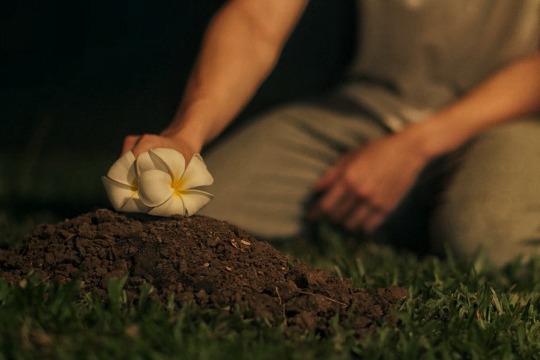
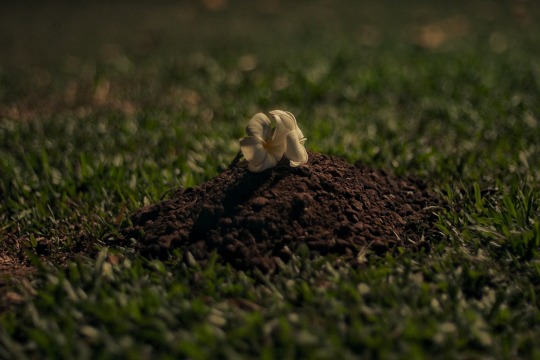
KinnPorsche -- Remember our Khun Spike. Plumeria flowers here were used as offering or signage on top of the grave.

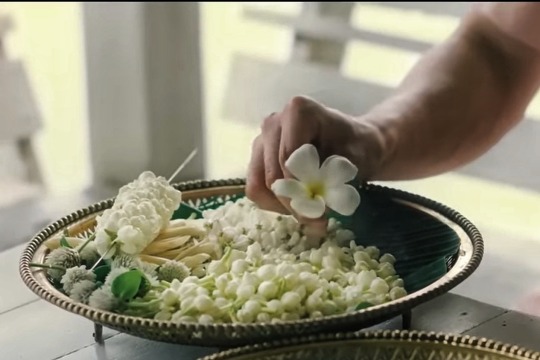
I Feel You Linger in the Air -- A Plumeria flower here was used as a prop, depicted falling from the sky onto the top of a plate of jasmines. It might hold some symbolisms: a welcome, an openness, or transfer of 'spirit' or soul across the time dimension.
Next, I plan to write about jasmine (Part 2) and hibiscus (Part 3).
Sources: [1] [2] [3] [4] [5] [6] [7] and the book "A Field Guide to Tropical Plants of Asia" by Engel & Phummai, 2008.
#flower in dramas#flowers#tropical flowers#plumeria#frangipani#i feel you linger in the air#kinnporsche#i'm tagging the shows for organization purpose#*this is why i don't write much here it took me so long to compile things i wanted to say :')
38 notes
·
View notes
Note
I'm part Filipino; are there any Philippines-native snakes that you can share?
Absolutely!! There are plenty of awesome snakes native to the Philippines.
The Philippines are home to the Paradise flying snake (Chrysopelea paradisi)! These guys are members of the genus of flying snakes, who can glide from tree to tree by flattening their bodies out like frisbees.


Mangrove snakes (Boiga dendrophila) are awesome. These guys are the biggest cat-eyed snakes in the world (6-8 feet long in a genus where 1.5-2 feet long is average). They're rear-fanged venomous colubrids, and although their venom isn't medically significant to humans, it's supposed to be much more unpleasant than a hognose's.
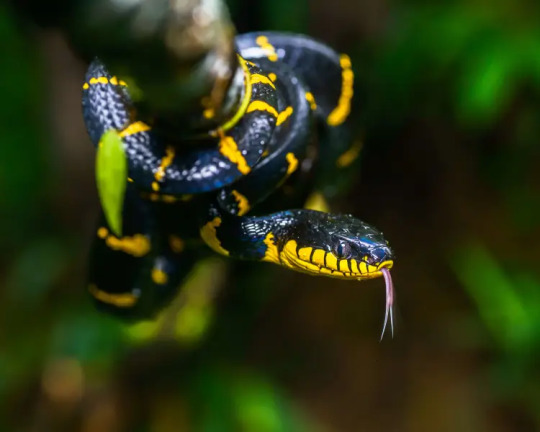
Triangle-spotted snakes (genus Cyclocorus) have a soft spot in my heart. They're teeny little snakes (just over a foot long on average), specialized for eating even smaller snakes! They have very unique teeth - their teeth increase in size towards the back of their mouth, ending in two unusually large teeth near the end. They're not venomous - that's probably to help them eat reptilian prey easily! They belong to their own family, but they're more closely related to elapids than to colubrids.

Bluntheaded slug snakes (Aplopeltura boa) are my best friends. Look at them. As you might guess from the name, they eat slugs. 10/10, no notes.


Dog-toothed cat snakes (Boiga cynodon) are a species I'd love to talk about all day long! They're so cool! Like mangrove snakes, their cousins, they're big for cat-eyed snakes (around 6 feet for these guys). They get their name from their huge teeth - they have big teeth because they're specialized for snatching birds out of the air as they're flying by!
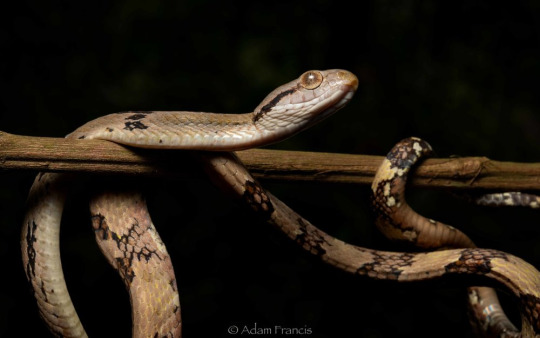
They flatten out their necks vertically when they're upset! Lots of Old World snakes do this, but they're particularly dramatic about it.

They like to rest on branches like green tree pythons. They're amazing. Dog-toothed cat snakes my beloveds.

Philippine pit vipers (Trimeresurus flavomaculatus) are close relatives to white-lipped tree vipers! These guys are unique to the Philippines.

The Philippines is home to several cobras, but one of the coolest is the Samar cobra (Naja samarensis)! These guys are bright yellow spitting cobras! Spitting cobras are able to spit venom through specialized holes in their fangs. It's kinda like being both melee and ranged-weapon equipped. They've evolved to aim for the eyes!

Finally, in waters off the Philippine islands, you can find my personal favorite sea snake, the yellow-bellied sea snake (Hydrophis platurus)! These are some of the most widely-distributed sea snakes in the world - they're found in tropical ocean waters around the world, excepting the Atlantic. A fun sea snake fact: they actually can't drink salt water! They have to drink fresh water from rain as it collects along the top of the ocean water. Yellow-bellied sea snakes can go for up to seven months without freshwater during times of drought!

192 notes
·
View notes
Text

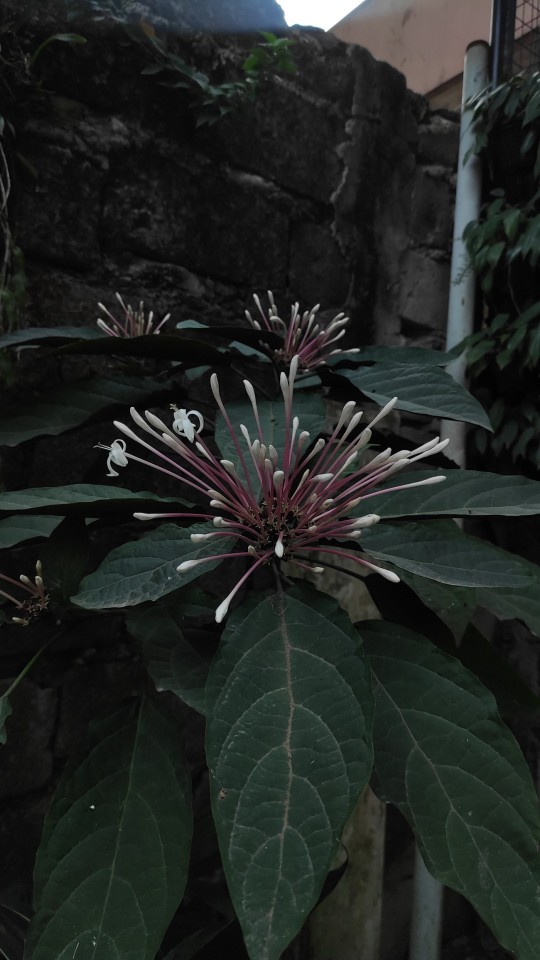
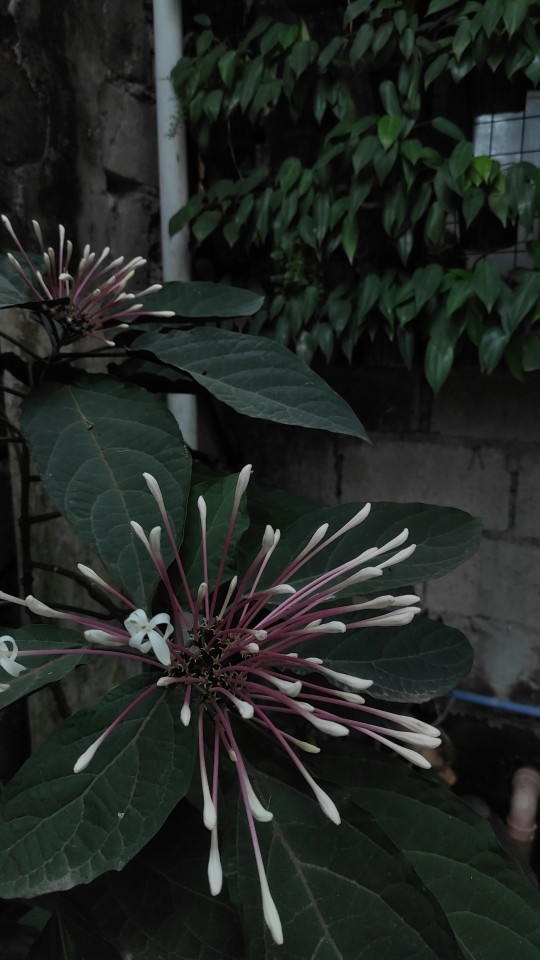
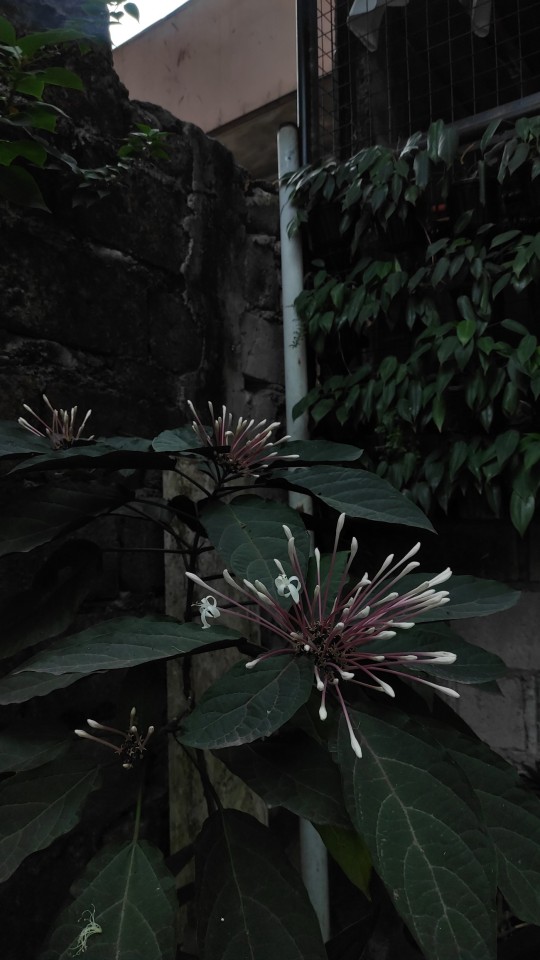
Our little Bagawak Morado plant is starting to bloom! ✨ Mas maganda yung sa neighbor namin kasi mayabong na, pero we're so happy! This one's native in the Philippines and blooms in January, siguro kaya tawag din sa kanya ay fireworks.
17 notes
·
View notes
Text

10 years ago I took photos of trees newly planted on the campus of UP Diliman. I went back to take pictures of them again to see how big they've grown. What makes these trees special is that they are native to Philippine forests, many represent species long forgotten, or even near extinction.
2013 was also my first year designing for non-profits, specifically in the environmental movement. Today I still make art about the environment through my @philippinewildlifeart project. Sometimes I like to think that these trees are physical representations of how far I've grown, and how far I've yet to go.
See 20 of the trees side-by-side with their "baby pictures", with a bit of "tree-via" on each species:
https://filipeanut.art/a-10-year-old-forest-of-native-trees-in-metro-manila-before-and-after/
5 notes
·
View notes
Note
I love the names of the bear cats! Bali and Palaw are adorable names! Which language is that? I'm guessing something South Asian, but I'm not sure. Also, I love how they are referred to as Hector's animal siblings. That kinda reminds me of how the Native Americans consider the animals as their younger siblings or "Little Brother/Sister" in their culture. Was it possibly inspired by that? That awesome if so!
Thanks for the ask JP!
I'm glad you love my names for the bearcats! 😄 They're actually named after irl places; 'Bali' ("Bah-lee") is an island in Indonesia, and Palawan ("pahl-ow-wan") is an archipelago in the Philippines! I originally named one of them 'Palaw' ("pahl-ow") because there's a specific subspecies of bearcat (aka 'binturong') native to that archipelago, and they're commonly referred to as the 'Palawan Bearcat.' After that I was like, "I want them to have themed/matching names, what's another Southeast Asian island I can use for her sister?" and decided on Bali!
And funnily enough, their relationship with Hector isn't culture or religion based at all! In my fanfic, Hector was essentially "adopted" by their mother when he was a child, and they all got to grow up together in a sense. Bali and Palaw were practically newborns when Hector came into their lives, and as a result they don't actually consider him to be a different species. In their eyes he's a malformed/disabled bearcat who needs their protection and help since he has no fur, or claws, or a prehensile tail, or wrists that can turn 180 degrees for climbing headfirst down a tree. (Similar to how cats see humans as especially helpless babies that need to be hunted for and spoken to on "kitten frequency".)
There's an ADORABLE video on Youtube of Dr. Evan Antin meeting a baby binturong to give her some medical care, and he drops some facts about binturongs and why he loves them! (You can also hear him pronounce Palaw's name as intended, lol 🤣):
youtube
(I'll stop myself before I spam you with binturong videos)
#ask answered#fic asks#fanfic asks#tts hector#hector tts#incarnate fic#hector's bearcats#hector's binturongs#binturong facts#bearcat facts#tts fanfic
21 notes
·
View notes
Text




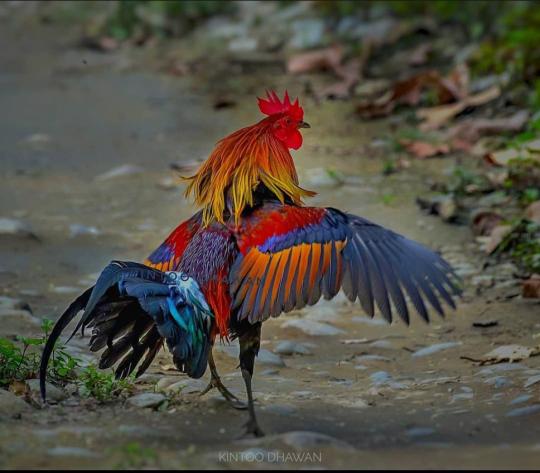
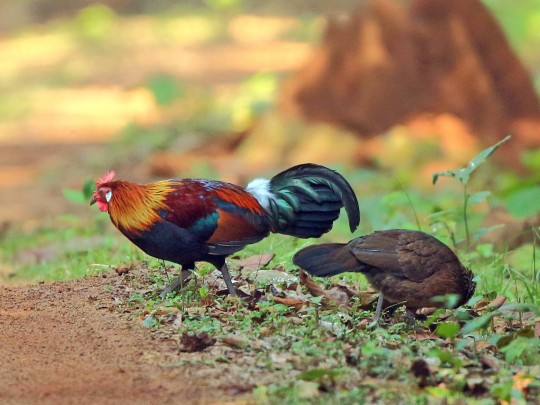


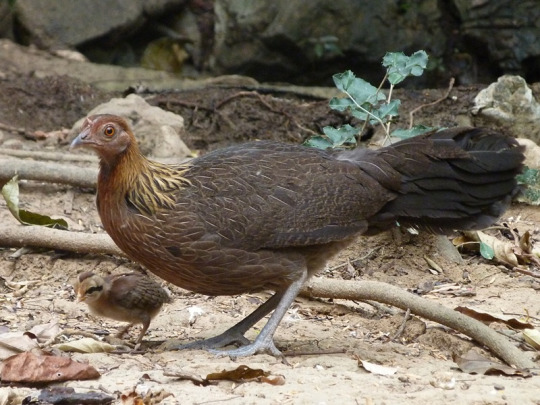

Gallus gallus better known as the red jungle fowl, the bankiva, the wild chicken, or the bankiva fowl, is a species of tropical bird in the family Phasianidae which is native throughout much of south east asia from India, Nepal and Bangladesh in the west, and eastwards across southern China, to Indochina; south/southeast into Malaysia, Singapore, the Philippines, and Indonesia. Red junglefowl are also the primary wild ancestor of the various breeds of domestic chickens, with humans first keeping and domesticating these birds some 8,0000 years ago. As such like its domestic descendants, was brought with and introduced to various regions across the world most notably Micronesia, Melanesia, Australia, and Polynesia. Here they inhabit all range of forests and woodlands as well as plantations, orchards, and agricultural areas. They live in flocks consisting of a few roosters and several hens and there offspring, often lead by a dominant male who maintains a small territory often centered around ideal roosting spots. They feed upon fruit, seeds, insects and other invertebrates, grains, leaves, stems, bamboo, grasses, roots, tubers, and the occasional small rodent or lizard. Jungle fowl are in turn eaten by a plethora or predators including various cats, civets, canines, primates, hyenas, lizards, snakes, crocodilians, coconut crabs, bears, marsupials, and predatory birds. Female red jungle fowl typically reach around 2.25lbs (1kg) in weight and 17 inches (43.2 cms) in length, while males can get to about 3.25 (1.5kg) in weight and 30 inches (76.2cms) in length. The males coloration is a vibrant mix of orange, brown, red, gold, grey, white, olive and even metallic green feathers. In contrast females are typically much more muted in plumage. Males also sport a long tall and larger combs and wattles than females. Flight in these birds is almost purely confined to reaching their roosting areas at sunset in trees or any other high and relatively safe places free from ground predators, and for escape from immediate danger through the day. Breeding occurs in the dry season, during which time males impress females by performing a display called "tidbitting" in which they dance, call, bobble, and brings the female food. After mating the female will lay an egg a day, for up to 12 days, and incubate them for 21 days until hatching. The young fledge at around 5 weeks of age, and at 12 weeks they are forced out of there mothers flock and must set off to join another or form there own. Under ideal conditions a red jungle fowl will reach sexual maturity at around 5 months of age and may live up to 30 years.
#pleistocene pride#pleistocene#pliestocene pride#pliestocene#cenozoic#ice age#stone age#dinosaur#bird#red#jungle#fowl#red junglefowl#junglefowl#chicken#asia#polynesian
7 notes
·
View notes
Text


Masungi Georeserve on Twitter @MasungiGeo:
The Bignay tree (Antidesma bunius) is a fascinating Philippine-native tree that boasts verdant green leaves and produces small, round, and colorful red to purple berries. These berries are not only visually appealing but are edible.
Bignay tree plays a vital role in supporting biodiversity and its robust root system helps prevent soil erosion and stabilizes the surrounding environment. #SaveMasungi
7 notes
·
View notes